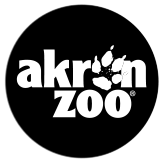“Everybody poops!” may be a common phrase uttered by parents all over the globe while they potty train their toddlers, but it also applies to animals! The difference is, animals don’t have toilets to flush their poop, so what do we do with it?
The Akron Zoo’s Green Team is responsible for handling many of the zoo’s green initiatives, including thinking creatively about how to address the issue surrounding animal waste. Keeping with our conservation efforts, they wanted to find a solution that would keep our animal waste from, well, going to waste. The solution: composting!
Through research, the Green Team narrowed down a wide range of composting methods to the best option for our park, and on April 23, 2018, we installed the Big Hanna Composter as part of our Earth Day Celebrations. Big Hanna is a large, in-vessel composting unit that does not require any additives for the composting process. Instead, we “feed” her a mixture of animal waste and sawdust, as well as a small amount of food waste, which the onboard computer software automatically rotates once every hour. After six to ten weeks, this mixture becomes compost!
 Every day our custodial technicians collect and weigh the previous day’s animal waste. This is one of the most important parts of the composting process; without the weight, the team would not be able to calculate how much sawdust should be added. Once the poop has been weighed and the sawdust has been added, it is time to “feed” Hanna. Feeding Hanna can be dangerous because we use a large shredder to break down the material and an auger to pull the material up to the intake chute of the composter. The shredder and auger were added to our Big Hanna unit because of the sheer volume put into the composter, daily. To ensure safety, there are always three staff members involved in the feeding process: one person pouring waste into the shredder, one person monitoring Hanna’s intake and a remote supervisor who is able to call for help or support in case of an emergency.
Every day our custodial technicians collect and weigh the previous day’s animal waste. This is one of the most important parts of the composting process; without the weight, the team would not be able to calculate how much sawdust should be added. Once the poop has been weighed and the sawdust has been added, it is time to “feed” Hanna. Feeding Hanna can be dangerous because we use a large shredder to break down the material and an auger to pull the material up to the intake chute of the composter. The shredder and auger were added to our Big Hanna unit because of the sheer volume put into the composter, daily. To ensure safety, there are always three staff members involved in the feeding process: one person pouring waste into the shredder, one person monitoring Hanna’s intake and a remote supervisor who is able to call for help or support in case of an emergency.
Maturing compost can be viewed in the beginning and end stages of the process through two portholes in Big Hanna. Our Park Services Supervisor opens these ports weekly to monitor progress. Since composting creates harmful fumes, it is important that he or she wears the proper personal protective equipment (PPE) when the portholes are open, which includes a mask and goggles. During the check, he or she is monitoring for moisture content and airflow. If the airflow ports are clogged, the in-vessel temperatures may become too high, altering the process, so these may need to be unclogged manually. Big Hanna’s onboard computer also allows for automated adjustments to be made to her operation in response to how the compost is maturing. If the compost is too wet we can adjust the airflow, or add more sawdust to our formula.
 After six to ten weeks the finished compost comes out the end chute of Big Hanna and is given to our horticulturists, who are able to collect and use the compost on site. Since the main ingredient of our formula is animal waste, the resulting compost has a high pH level. Knowing the pH level of the compost is important for our horticulturists because some plants prefer specific pH levels. Our horticulturists test the soil before adding compost to know how best to utilize it throughout the park. By making our own compost, we are able to keep the Akron Zoo green and beautiful while also reducing our waste!
After six to ten weeks the finished compost comes out the end chute of Big Hanna and is given to our horticulturists, who are able to collect and use the compost on site. Since the main ingredient of our formula is animal waste, the resulting compost has a high pH level. Knowing the pH level of the compost is important for our horticulturists because some plants prefer specific pH levels. Our horticulturists test the soil before adding compost to know how best to utilize it throughout the park. By making our own compost, we are able to keep the Akron Zoo green and beautiful while also reducing our waste!
So Happy Earth Day, and happy two year anniversary, Big Hanna! Thank you for helping us think green, both in our gardens and our composting! If you are interested in composting at home there are many resources online to help you get started. If composting isn’t for you there are many other actions you can take daily to make a difference for the planet!
